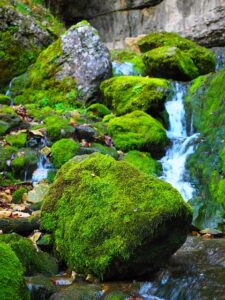 Greetings, subscribers. Today, we learn about the intriguing life of mosses and other things in the following article by my friend, the naturalist and author, Peggy Sias Lantz. Enjoy!
Greetings, subscribers. Today, we learn about the intriguing life of mosses and other things in the following article by my friend, the naturalist and author, Peggy Sias Lantz. Enjoy!
Moss and Other Things
Peggy Lantz speaks
I’m reading a book I must share with you. It is called Gathering Moss:A Natural and Cultural History of Mosses and was written by Robin Wall Kimmerer. Yes, it is about mosses and includes a lot of scientific information and botanical nomenclature. But Kimmerer is of Potawatami heritage and brings Native American insights into her science and writing.
I’m not a scientist. I struggled with any kind of math and science in high school and college. I’m a musician and writer. How I became a writer of scientific information I cannot begin to tell you. But I delight in reading beautifully written and easily assimilated scientific information, and this book is a treasure.
I will not be pursuing the study of mosses with a magnifying glass on my hands and knees, but I’m glad that Kimmerer has done it. I’ll never remember the botanical names of the mosses she describes, but I will remember her comparison of a miniature forest of mosses with the macrocosm of the Amazon rainforest.
Robin Wall Kimmerer’s book excerpt
This excerpt from her book touches me deeply. I have long felt that our attitude toward plants and animals being only for our use, giving us the right to use them even to extinction, is so terribly wrong. I hope this will give you pause for thought, too.
“In indigenous ways of knowing, it is understood that each living being has a particular role to play. Every being is endowed with certain gifts, its own intelligence, its own spirit, its own story. Our stories tell us that the Creator gave these to us, as original instructions. The foundation of education is to discover that spirit within us and learn to use it well.
“These gifts are also responsibilities, a way of caring for each other. Wood Thrush received the gift of song; it’s his responsibility to say the evening prayer. Maple received the gift of sweet sap and the coupled responsibility to share that gift in feeding the people at a hungry time of year. This is the web of reciprocity that the elders speak of, that which connects us all. I find no discord between this story of creation and my scientific training. This reciprocity is what I see all the time in studies of ecological communities. Sage has its duties, to draw up water to its leaves for the rabbits, to shelter the baby quail. Part of its responsibility is also to people. Sage helps us clear our minds of ill thoughts, and carry our good thoughts upward. The roles of mosses are to clothe the rocks, purify the water, and soften the nests of birds.”
—Robin Wall Kimmerer is a professor at SUNY College of Environmental and Forest Biology in Syracuse, New York. She won the John Burroughs medal for natural history writing and also wrote Braiding Sweetgrass, a New York Times bestseller (which I will be reading next).
—END—
Also, check out this wonderful resource: Why insects are so crucial to life on Earth – BBC Ideas
Thanks for reading!
Your writer on the wing,
Charlene






Candy Dawson
Such a lovely piece reminding us of this beautiful “grand scheme” of life on planet earth. Oh, if only American Indigenous People could have directed our environmental agenda…I feel better now that Deb Haaland is in the Cabinet.
Steve
???❤️